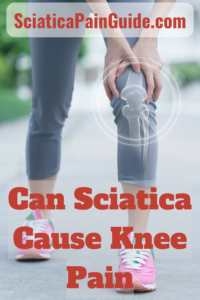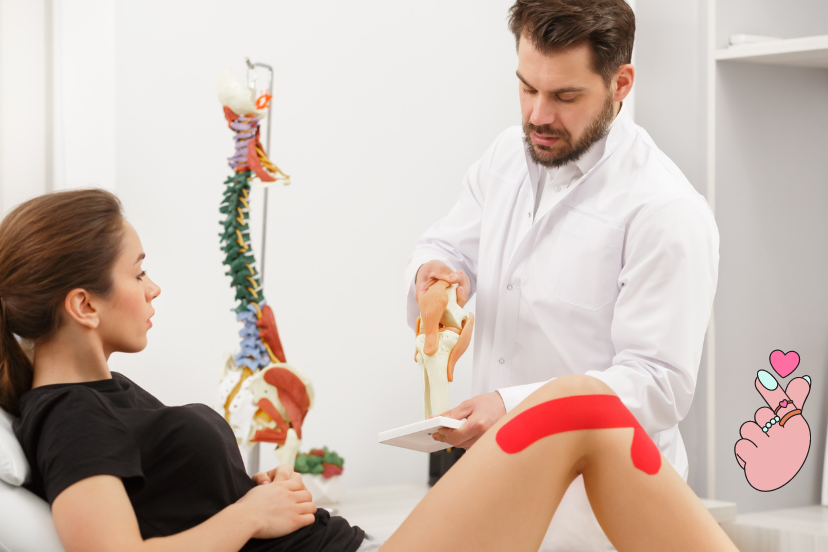Can Sciatica Cause Knee Pain
Explore the link between sciatica and knee pain. Can sciatica cause knee pain? Uncover causes, symptoms, treatments, and relief strategies. As a researcher who has spent considerable time studying sciatica, I often come across one common question, “Can sciatica cause knee pain?” My answer? Absolutely! But to truly understand this, we must first delve into sciatica’s basics.
Understanding What Is Sciatica Pain
Sciatica, at its core, is a nerve issue. It involves the irritation or compression of the sciatic nerve, the longest nerve running from your lower back, through the hips and buttocks, and down each leg.
The Connection Between Sciatica And Knee Pain
The relationship between sciatica and knee pain comes down to that very nerve path. If your sciatic nerve is irritated or compressed, that discomfort can radiate along its path and potentially reach your knee.
The Sciatic Nerve And Its Role In Knee Pain
The sciatic nerve branches into smaller nerves as it travels down the leg. Some of these branches supply the knee area, explaining why an issue with the sciatic nerve can cause knee pain.
Causes Of Sciatica Leading To Knee Pain
Several conditions can lead to sciatica, which may then result in knee pain. They include:
- Herniated Disc: This occurs when the inner gel of a spinal disc protrudes through the outer layer, potentially compressing the sciatic nerve.
- Piriformis Syndrome: The piriformis muscle located in the buttocks can spasm and irritate the sciatic nerve, leading to pain.
- Spinal Stenosis: This condition, characterized by the narrowing of the spine, can press on the sciatic nerve.
Can Sciatic Nerve Cause Knee Pain?
The sciatic nerve can cause knee pain. The sciatic nerve, the longest nerve in the body, originates in the lower back and runs down the back of each leg. Irritating or compressed can cause pain, numbness, or tingling in the lower back, buttocks, legs, and even the knee. The pain might feel sharp or burning. Although the primary areas affected are often the lower back and hips, the discomfort can radiate down to the knee, making some individuals mistakenly believe they have a knee issue. Proper diagnosis and treatment can help address the root cause and relieve the pain.
Can Sciatica Cause Knee Pain And Swelling?
Sciatica can cause knee pain. The sciatic nerve starts in the lower back and runs down the back of each leg. When something irritates or compresses this nerve, it can trigger pain, numbness, or tingling from the lower back down to the legs, including the knee. While sciatica primarily affects the lower back and hips, the pain can extend to the knee, making some people think they have a knee problem. However, sciatica typically does not cause knee swelling. If there’s swelling in the knee, it’s essential to consider other conditions or injuries that might be responsible. Always consult a doctor for a proper diagnosis.
Can Knee Pain Be Caused By Sciatica?
Sciatica can cause knee pain. The sciatic nerve begins in the lower back and extends down the back of each leg. When compressed or irritated, this nerve can produce pain, numbness, or tingling in areas ranging from the lower back to the legs, including the knee. Though sciatica mainly impacts the lower back and hips, the discomfort can reach the knee. This situation might lead some to believe they’re facing a knee-specific issue. However, it’s crucial to pinpoint the actual cause of the pain. If knee pain arises, especially alongside other symptoms, seeking medical advice is essential for an accurate diagnosis and treatment.
Can My Sciatic Nerve Cause My Knee To Hurt?
Your sciatic nerve can make your knee hurt. The sciatic nerve starts in your lower back and runs down the back of each leg. If something compresses or irritates this nerve, it can result in pain, numbness, or tingling in areas from the lower back to the legs, including the knee. While most people associate sciatica with lower back and hip discomfort, the pain can extend to the knee. This might lead you to think you have a knee issue. If your knee hurts, especially with other sciatic symptoms, seeking medical attention to determine the exact cause and appropriate treatment is essential.
Can Sciatica Cause Knee Buckling?
Sciatica can lead to knee buckling. The sciatic nerve begins in the lower back and extends down both legs. If irritated or compressed, this nerve can create pain, numbness, or weakness in areas from the lower back to the legs. The weakness, especially in the leg muscles, might cause the feeling of the knee giving way or buckling. While many associate sciatica with back and hip pain, its effects on leg strength can indirectly impact the knee’s stability. If you experience knee buckling along with other sciatic symptoms, it’s crucial to consult a medical professional for proper diagnosis and treatment.
Can Sciatica Cause Outer Knee Pain?
Sciatica can cause outer knee pain. The sciatic nerve originates in the lower back and extends down both legs. Compressed or irritated can lead to symptoms ranging from the lower back to the foot, impacting areas like the outer knee. While most associate sciatica with pain in the lower back and hips, its effects can radiate to the outer knee. This can lead individuals to think they have a knee-specific issue mistakenly. If you experience outer knee pain accompanied by other sciatic symptoms, it’s essential to consult a medical professional for an accurate diagnosis and suitable treatment.
Can Sciatica Cause Calf Pain?
Sciatica can cause calf pain. The sciatic nerve originates in the lower back and runs down both legs. If something irritates or compresses this nerve, it can lead to pain, numbness, or tingling that extends from the lower back to various parts of the leg, including the calf. Many people recognize sciatica by its characteristic lower back and hip pain, but its influence can stretch down to the calf and even the foot. If you experience calf pain along with other signs of sciatica, it’s essential to see a medical professional for accurate diagnosis and appropriate treatment.
Symptoms Indicating Your Sciatica Is Causing Knee Pain
Sciatica Of The Knee Symptoms
Sciatica can cause knee pain, numbness, tingling, and muscle weakness. These symptoms might radiate from the lower back through the thigh and knee. It’s essential to consult a doctor for a proper diagnosis and treatment.
Sciatica-induced knee pain may present several symptoms, including:
- Sharp Pain: This is often described as a shooting or jolting pain that may extend from the lower back to the knee.
- Numbness or Weakness: You may feel a sense of numbness or weakness in your knee or leg.
- Tingling or Burning Sensation: This might be experienced in your knee or along the sciatic nerve path.
What Does Knee Pain From Sciatica Feel Like?
Knee pain resulting from sciatica has distinct characteristics:
- Sharp or Burning Sensation: Pain can feel like a sudden jolt or a constant burning.
- Radiating Pain: Discomfort often starts in the lower back or hip and travels down the leg to the knee.
- Numbness or Tingling: Alongside pain, you might feel pins and needles in the knee area.
- Muscle Weakness: The affected leg may feel weak, impacting the knee’s stability.
- Aggravation with Movement: Sitting for long periods or sudden movements can intensify the pain.
- Intermittent Pain: It might not be constant, coming and going based on activity and posture. Always consult a medical professional for accurate diagnosis.
Treatment Options For Sciatica-Induced Knee Pain
What Helps Knee Pain From Sciatica?
To alleviate knee pain resulting from sciatica, adopt these strategies:
- Rest: Give the inflamed nerve time to heal.
- Apply Ice: Cold packs for 15-20 minutes can diminish inflammation.
- Heat: After initial inflammation lessens, heat can relieve and relax muscles.
- Engage in Stretching: Gentle stretching exercises can relieve tension in the back and legs.
- Over-the-counter pain relievers: NSAIDs (Non-steroidal anti-inflammatory drugs) help reduce pain and inflammation.
- Undergo Physical therapy: Therapists provide exercises to bolster supporting muscles.
- Maintain Proper Posture: Ensuring a good posture prevents undue nerve compression.
- Avoid Sitting for Long Periods: Stand or walk at intervals.
- Wear Supportive Shoes: Proper footwear can mitigate undue strain.
- Consult a Doctor: Always seek expert advice if pain persists or intensifies.
How Long Does Sciatica Of The Knee Last?
The duration of sciatica-related knee pain varies:
- Typical Cases: Most people experience relief within a few weeks with proper care and treatment.
- Severe Cases: Some might endure pain for several months.
- Prompt Treatment: Seeking early intervention, like physical therapy or medications, can speed up recovery.
- Activity Levels: Gentle movement and stretches often help, but overexertion can prolong symptoms.
- Underlying Causes: The duration largely depends on what’s causing the sciatica. A herniated disc might heal faster than conditions like spinal stenosis.
- Recurrence: Some may experience recurrent episodes.
Consult a doctor to address the root cause and develop a tailored treatment plan.
Lifestyle Changes And Home Remedies
Apart from medical treatments, adopting specific lifestyle changes and home remedies can also help alleviate sciatica-induced knee pain:
Regular Exercise
Regular low-impact exercises like walking and swimming can help keep your body fit and reduce the chances of nerve compression.
Sciatic Nerve Knee Pain Exercises
Exercise can play a vital role in managing sciatica and associated knee pain. Here’s how:
- Strengthens Muscles: Regular exercise strengthens the muscles in your back, abdomen, and legs. Strong muscles provide better support for your spine and reduce the pressure on the sciatic nerve.
- Improves Flexibility: Exercise can enhance the flexibility of your muscles and joints, which can help reduce the compression of the sciatic nerve.
- Promotes Better Posture: Regular physical activity helps improve your posture. Good posture can prevent undue stress on your back and the sciatic nerve.
- Enhances Blood Circulation: Exercise increases blood flow, including the lower back. Improved blood circulation can speed up the healing process and reduce the inflammation that may be causing sciatica and knee pain.
- Maintains Healthy Weight: Regular physical activity helps in maintaining a healthy weight. Being overweight can add pressure to the spine and the sciatic nerve.
- Releases Endorphins: Exercise releases endorphins, the body’s natural painkillers. These chemicals help reduce pain and improve your mood.
Focusing On Low-Impact Exercises
While exercising, focusing on low-impact exercises that don’t put too much stress on your sciatic nerve is crucial. Walking, swimming, and yoga are often recommended. Incorporating stretching exercises, such as the knee-to-chest stretch, sciatic mobilizing stretch, and back extensions, is also advised.
Remember, it’s always a good idea to consult a healthcare professional or a physical therapist before starting a new exercise regimen to ensure it’s safe and appropriate for your specific condition.
Maintaining Proper Posture

Good Posture
Maintaining proper posture, especially while sitting and lifting heavy objects, can decrease the pressure on your sciatic nerve. Maintaining good posture is crucial in managing sciatica and associated knee pain. Here’s how it can be helpful:
Minimizes Pressure On The Spine: A good posture ensures that your body’s weight is evenly distributed, reducing undue pressure on your spine and other joints. This can alleviate stress on the sciatic nerve and reduce knee pain.
Prevents Nerve Compression: Poor posture can lead to nerve compression in your lower back, a common cause of sciatica. Maintaining an upright posture, especially while sitting for long periods, can help prevent such compression.
Promotes Better Alignment: Proper posture helps align your body correctly – from the head, through the spine, to the hips and knees. This alignment minimizes strain on your muscles, joints, and nerves, including the sciatic nerve.
Supports Muscle Health: When you have good posture, your muscles work more efficiently, reducing the likelihood of muscle strain and overuse. This can indirectly benefit sciatica and knee pain by keeping the supporting muscles strong and healthy.
Prevents Future Complications: Good posture can help manage current symptoms and prevent future spinal and joint problems, including the worsening of sciatica and knee pain.
It’s important to note that improving posture involves awareness of your body positioning and strengthening exercises. Be mindful of your posture when sitting, standing, and lifting heavy objects. Incorporate exercises that strengthen your core and back muscles, as they significantly maintain your posture. Remember, drastic changes in posture should be made gradually, and seeking advice from a professional.
Hot And Cold Compresses
These can help relieve the inflammation and thus ease the pain. For sciatica and knee pain, hot and cold compresses can be effective:
- Apply a cold pack for 15-20 minutes to reduce inflammation.
- After the initial swelling subsides, use a hot compress to relax muscles and improve blood flow.
- Alternate between hot and cold for optimal relief.
- Always use a cloth barrier to prevent skin burns or frostbite.
- Consult a doctor for persistent pain.
Sciatica And Knee Pain At Night
Sciatica can intensify knee pain at night. The sciatic nerve, originating in the lower back and traveling down the legs, can cause pain, numbness, or tingling when irritated. Compression or inflammation of this nerve can result in symptoms radiating to the knee. Sleeping in certain positions may exacerbate this pain. To alleviate nighttime discomfort:
- Adjust sleeping positions: Lying on the unaffected side with a pillow between the knees can help.
- Use supportive mattresses and pillows.
- Stretch gently before bed.
- Apply heat or cold packs for relief.
- Take over-the-counter pain relievers as recommended.
- Consult a doctor if nighttime pain becomes unbearable.
When To Seek Medical Help
Seek medical help for sciatica and knee pain when:
- Pain persists beyond a few weeks.
- Symptoms intensify or disrupt daily activities.
- You experience severe or sudden pain.
- Numbness or weakness spreads in the leg.
- Pain follows a traumatic event, like a car accident.
- Bowel or bladder function changes occur.
- Sleep gets consistently interrupted due to pain.
- Over-the-counter treatments don’t provide relief. Early medical intervention can lead to more effective treatment and better outcomes.
Can Sciatica Cause Knee Pain – Conclusion
To wrap things up, yes, sciatica can cause knee pain. Understanding the root cause and identifying the symptoms early on can go a long way in managing the condition effectively. Remember, while self-care measures like heat or ice are beneficial, professional medical advice should never be overlooked.
Please note that this article should not replace professional medical advice. Consult a healthcare professional for an accurate diagnosis and tailored treatment plan.
Frequently Asked Questions (FAQs)
Does sciatica always cause knee pain?
No, sciatica doesn’t always cause knee pain. It depends on where the sciatic nerve is compressed or irritated.
Can sciatica-induced knee pain be permanent?
Generally, no. With appropriate treatment, the pain should diminish over time. However, chronic conditions might need long-term management.
Are there exercises to help with sciatica-induced knee pain?
Specific exercises focusing on stretching and strengthening your lower back, abdomen, and thighs can help alleviate the pain.
Can weight loss help with sciatica-induced knee pain?
Maintaining a healthy weight can reduce pressure on your spine and help prevent sciatica and subsequent knee pain.
Can I prevent sciatica and the associated knee pain?
While not all causes of sciatica can be prevented, maintaining a healthy lifestyle, including regular exercise, proper posture, and a balanced diet, can significantly reduce your risk.
How do I get rid of knee pain from sciatica?
To relieve knee pain from sciatica, Rest and avoid straining the area. Apply cold packs for inflammation. Use heat to relax muscles. Take over-the-counter pain relievers. Engage in guided stretching. Consult a doctor for tailored advice.





